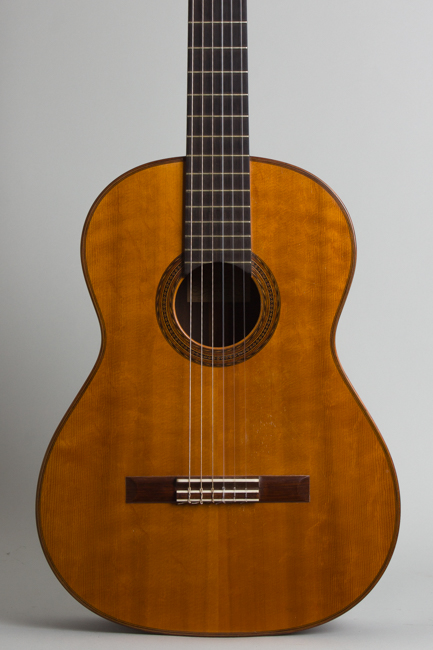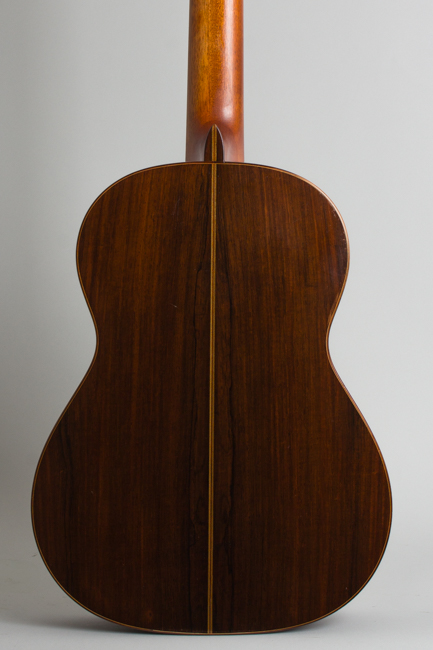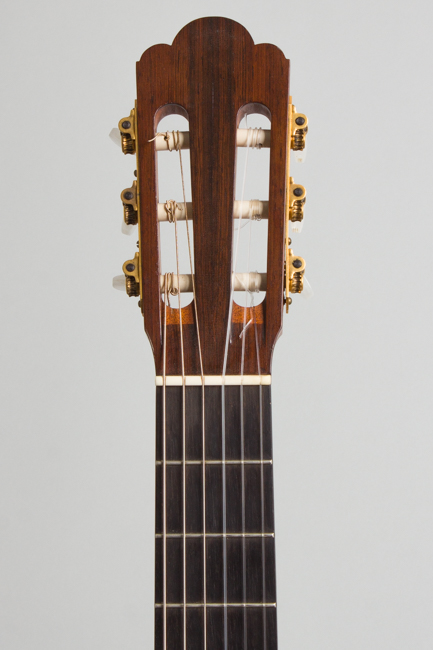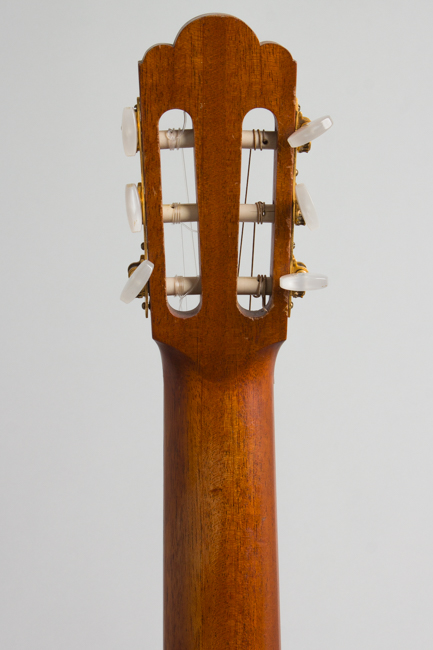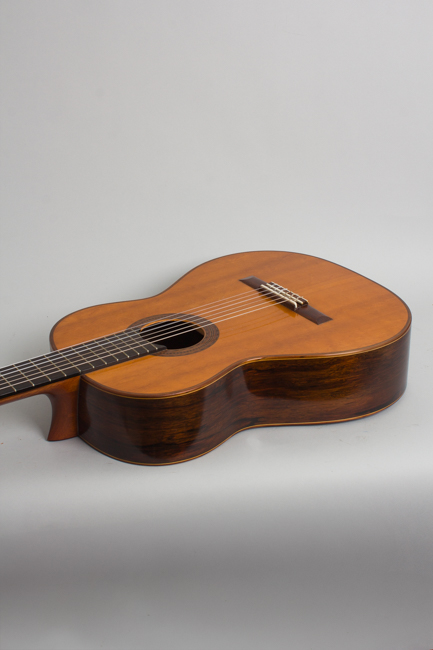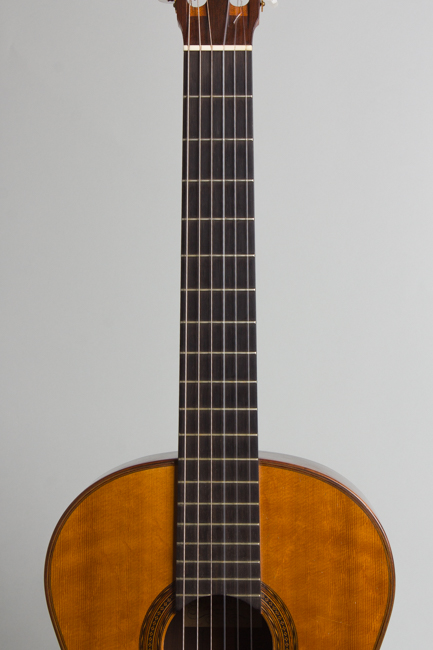Manuel Velazquez Classical Guitar (1971)
Manuel Velazquez Classical Guitar (1971), made in New York, French polish finish, Brazilian rosewood back and sides, cedar top, Spanish cedar neck with ebony fingerboard, Mark Leaf black hard shell case.
This truly superb classical guitar is the work of one of 20th century New York's most renowned luthiers, Manuel Velazquez. It was made in 1971, labeled "Manuel Velazquez, Constructor de Guitarras, New York." The elegantly simple label is hand signed by Velazquez and also has the date, "ano 1971", written by hand in brown ink. The guitar also has hidden signatures on the underside of the top, off each side of the fingerboard extension.
Manuel Velazquez was born in February 1917, in Manati, Puerto Rico, the twelfth of 13 children. His foray into woodworking began as an adolescent, working in his older brother's furniture shop. The workshop also fabricated cuatros, which became the catalyst for Manuel's interest in building guitars. He completed his first guitar at age 16. Shortly after, he showed one to Jorge Rubiano, conductor of a large string orchestra. Impressed, Rubiano ordered two for the orchestra and soon became a source of encouragement and valuable critique. Thanks to Rubiano, a few orders began to come Manuel's way.
Rubiano also urged him to see Segovia in concert. Hearing Segovia's 1937 Hauser had a profound effect on Velazquez; it would become the standard reference of the instrument for the rest of his life. Thanks to Rubiano he was able to also analyze guitars by Antonio de Torres and Santos Hernandez, using them as references for his own instruments. In 1940 he moved to New York, working as a cabinet maker and joiner and as a carpenter in the Brooklyn Navy Yard. His first New York-made guitar was finished in 1942, made from Brazilian rosewood mess hall tables reclaimed from a sunken troop ship dismantled at the Navy Yard.
In 1948 Manuel established his first NYC workshop at 420 Third Avenue. Through the 1950s, he almost single-handedly maintained the tradition of European classical guitar making in the United States, producing over a thousand purely handmade instruments. In time Vladimir Bobri, Rey de la Torre, Saul Marantz, The Haines Bros., Alexander Bellows, Noah Wolfe, and more would come to know and recommend him as one the finest guitar makers in the world. Velazquez guitars have since that time been highly regarded for their elegance in tone quality, sustain and playability, achieved with critical selection and calibration of materials designed in the tradition of Torres, Hauser, and Santos Hernandez.
By 1960/1961, Velazquez incorporated his business with an aim to scale up his one man operation. Bringing on a small staff of fledgling luthiers under his guidance, the new business was split between two workshops; "Manuel Velazquez, Inc." in New York at 205 East 23rd Street and "Guitar Velazquez, Inc" in Caguas, Puerto Rico, established in 1963. This expanded venture was short lived; the workshop in Puerto Rico failed and in 1965 Velazquez reverted to building guitars on his own. This guitar is one of the last from this period before Velazquez closed up his NY shop in 1972 and relocated to Juana Diaz, Puerto Rico.
This is a typically elegant Velasquez concert guitar in his traditional Hauser mode. The back and sides are beautifully figured Brazilian rosewood, with all wood bindings and trim. The Spanish cedar neck has a 54mm nut width and a 650mm scale with a fairly typical "D" profile and is very comfortable to play. The rosewood-faced headstock has a simple round-peaked profile and the tuners are gold-plated Van Ghent strips typical of this era. The sound is deep and rich with considerable volume, and responds to a light touch while being capable of a wide dynamic range if forced. This is a particularly nice guitar from one of the later 20th century's most esteemed luthiers, a worthy instrument for the master player.
Overall length is 39 in. (99.1 cm.), 14 1/2 in. (36.8 cm.) wide at lower bout, and 4 in. (10.2 cm.) in depth at side, taken at the end block. Scale length is 25 1/2 in. (648 mm.). Width of nut is 2 1/8 in. (54 mm.).
This guitar shows some general wear overall from use over the decades but remains a superb instrument to play. There are picking marks into the top finish below the strings, extending under the fingerboard extension and small impact marks from numerous re-stringings behind the bridge. The back of the neck is partially worn to the wood with one light ding between the first and second frets. The guitar has survived nearly 55 years with no cracks or notable repairs. Overall, this is a well played but finely cared for instrument, a really super example of Sr. Velazquez's best work. A wonderful instrument to play, hear or appreciate it also stands as an important piece of guitar history, particularly as related to the traditions of both Puerto Rico and New York. The guitar resides in a large deluxe Mark Leaf case with built in humidity monitoring. Overall Excellent - Condition.
This truly superb classical guitar is the work of one of 20th century New York's most renowned luthiers, Manuel Velazquez. It was made in 1971, labeled "Manuel Velazquez, Constructor de Guitarras, New York." The elegantly simple label is hand signed by Velazquez and also has the date, "ano 1971", written by hand in brown ink. The guitar also has hidden signatures on the underside of the top, off each side of the fingerboard extension.
Manuel Velazquez was born in February 1917, in Manati, Puerto Rico, the twelfth of 13 children. His foray into woodworking began as an adolescent, working in his older brother's furniture shop. The workshop also fabricated cuatros, which became the catalyst for Manuel's interest in building guitars. He completed his first guitar at age 16. Shortly after, he showed one to Jorge Rubiano, conductor of a large string orchestra. Impressed, Rubiano ordered two for the orchestra and soon became a source of encouragement and valuable critique. Thanks to Rubiano, a few orders began to come Manuel's way.
Rubiano also urged him to see Segovia in concert. Hearing Segovia's 1937 Hauser had a profound effect on Velazquez; it would become the standard reference of the instrument for the rest of his life. Thanks to Rubiano he was able to also analyze guitars by Antonio de Torres and Santos Hernandez, using them as references for his own instruments. In 1940 he moved to New York, working as a cabinet maker and joiner and as a carpenter in the Brooklyn Navy Yard. His first New York-made guitar was finished in 1942, made from Brazilian rosewood mess hall tables reclaimed from a sunken troop ship dismantled at the Navy Yard.
In 1948 Manuel established his first NYC workshop at 420 Third Avenue. Through the 1950s, he almost single-handedly maintained the tradition of European classical guitar making in the United States, producing over a thousand purely handmade instruments. In time Vladimir Bobri, Rey de la Torre, Saul Marantz, The Haines Bros., Alexander Bellows, Noah Wolfe, and more would come to know and recommend him as one the finest guitar makers in the world. Velazquez guitars have since that time been highly regarded for their elegance in tone quality, sustain and playability, achieved with critical selection and calibration of materials designed in the tradition of Torres, Hauser, and Santos Hernandez.
By 1960/1961, Velazquez incorporated his business with an aim to scale up his one man operation. Bringing on a small staff of fledgling luthiers under his guidance, the new business was split between two workshops; "Manuel Velazquez, Inc." in New York at 205 East 23rd Street and "Guitar Velazquez, Inc" in Caguas, Puerto Rico, established in 1963. This expanded venture was short lived; the workshop in Puerto Rico failed and in 1965 Velazquez reverted to building guitars on his own. This guitar is one of the last from this period before Velazquez closed up his NY shop in 1972 and relocated to Juana Diaz, Puerto Rico.
This is a typically elegant Velasquez concert guitar in his traditional Hauser mode. The back and sides are beautifully figured Brazilian rosewood, with all wood bindings and trim. The Spanish cedar neck has a 54mm nut width and a 650mm scale with a fairly typical "D" profile and is very comfortable to play. The rosewood-faced headstock has a simple round-peaked profile and the tuners are gold-plated Van Ghent strips typical of this era. The sound is deep and rich with considerable volume, and responds to a light touch while being capable of a wide dynamic range if forced. This is a particularly nice guitar from one of the later 20th century's most esteemed luthiers, a worthy instrument for the master player.
Overall length is 39 in. (99.1 cm.), 14 1/2 in. (36.8 cm.) wide at lower bout, and 4 in. (10.2 cm.) in depth at side, taken at the end block. Scale length is 25 1/2 in. (648 mm.). Width of nut is 2 1/8 in. (54 mm.).
This guitar shows some general wear overall from use over the decades but remains a superb instrument to play. There are picking marks into the top finish below the strings, extending under the fingerboard extension and small impact marks from numerous re-stringings behind the bridge. The back of the neck is partially worn to the wood with one light ding between the first and second frets. The guitar has survived nearly 55 years with no cracks or notable repairs. Overall, this is a well played but finely cared for instrument, a really super example of Sr. Velazquez's best work. A wonderful instrument to play, hear or appreciate it also stands as an important piece of guitar history, particularly as related to the traditions of both Puerto Rico and New York. The guitar resides in a large deluxe Mark Leaf case with built in humidity monitoring. Overall Excellent - Condition.



